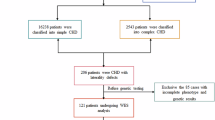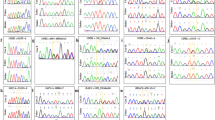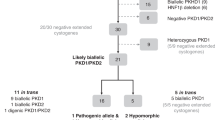Abstract
Heterotaxy syndrome is a very rare congenital disease, which is caused by the disorder of left-right asymmetry during visceral development. However, pathogenic genetic lesions are found in less than 20% of HS patients. In this cohort study, whole-exome sequencing was performed for 110 patients with situs inversus or situs ambiguous. We identified a novel nonsense variant in PKD1L1(c.1387 C > T; p.463Gln*) in a Chinese patient with heterotaxy syndrome and congenital asplenia. This homozygous variant caused the ___domain of PKD1L1 complete absence. To our knowledge, this novel variant is the first phenotype of congenital asplenia found in patients with PKD1L1 variants, and the first PKD1L1 variant found in China. Our findings expand the spectrum of PKD1L1 variants and provide support for PKD1L1 variant and congenital asplenia, and the critical role of PKD1L1 during left-right patterning in the Han Chinese population.
This is a preview of subscription content, access via your institution
Access options
Subscribe to this journal
Receive 12 print issues and online access
269,00 € per year
only 22,42 € per issue
Buy this article
- Purchase on SpringerLink
- Instant access to full article PDF
Prices may be subject to local taxes which are calculated during checkout




Similar content being viewed by others
References
Hamada H. Molecular and cellular basis of left-right asymmetry in vertebrates. Proc Jpn Acad Ser B Phys Biol Sci. 2020;96:273–96.
Sempou E, Khokha MK. Genes and mechanisms of heterotaxy: patients drive the search. Curr Opin Genet Dev. 2019;56:34–40.
Postema MC, Carrion-Castillo A, Fisher SE, Vingerhoets G, Francks C. The genetics of situs inversus without primary ciliary dyskinesia. Sci Rep. 2020;10:3677.
Lin AE, Krikov S, Riehle-Colarusso T, Frias JL, Belmont J, Anderka M, et al. Laterality defects in the national birth defects prevention study (1998-2007): birth prevalence and descriptive epidemiology. Am J Med Genet A 2014;164A:2581–91.
Gebbia M, Ferrero GB, Pilia G, Bassi MT, Aylsworth A, Penman-Splitt M, et al. X-linked situs abnormalities result from mutations in ZIC3. Nat Genet. 1997;17:305–8.
Bamford RN, Roessler E, Burdine RD, Saplakoglu U, dela Cruz J, Splitt M, et al. Loss-of-function mutations in the EGF-CFC gene CFC1 are associated with human left-right laterality defects. Nat Genet. 2000;26:365–9.
Yuasa T, Venugopal B, Weremowicz S, Morton CC, Guo L, Zhou J. The sequence, expression, and chromosomal localization of a novel polycystic kidney disease 1-like gene, PKD1L1, in human. Genomics 2002;79:376–86.
Vogel P, Read R, Hansen GM, Freay LC, Zambrowicz BP, Sands AT. Situs inversus in Dpcd/Poll-/-, Nme7-/-, and Pkd1l1-/- mice. Vet Pathol. 2010;47:120–31.
Vetrini F, D’Alessandro LC, Akdemir ZC, Braxton A, Azamian MS, Eldomery MK, et al. Bi-allelic mutations in PKD1L1 are associated with laterality defects in humans. Am J Hum Genet. 2016;99:886–93.
Lucas JS, Barbato A, Collins SA, Goutaki M, Behan L, Caudri D, et al. European Respiratory Society guidelines for the diagnosis of primary ciliary dyskinesia. Eur Respir J. 2017;49.
Quinodoz M, Peter VG, Bedoni N, Royer Bertrand B, Cisarova K, Salmaninejad A, et al. AutoMap is a high performance homozygosity mapping tool using next-generation sequencing data. Nat Commun. 2021;12:518.
Richards S, Aziz N, Bale S, Bick D, Das S, Gastier-Foster J, et al. Standards and guidelines for the interpretation of sequence variants: a joint consensus recommendation of the American College of Medical Genetics and Genomics and the Association for Molecular Pathology. Genet Med. 2015;17:405–24.
Matsui T, Bessho Y. Left-right asymmetry in zebrafish. Cell Mol Life Sci. 2012;69:3069–77.
Kurkowiak M, Zietkiewicz E, Witt M. Recent advances in primary ciliary dyskinesia genetics. J Med Genet. 2015;52:1–9.
Hildebrandt F, Benzing T, Katsanis N. Ciliopathies. N. Engl J Med. 2011;364:1533–43.
Field S, Riley KL, Grimes DT, Hilton H, Simon M, Powles-Glover N, et al. Pkd1l1 establishes left-right asymmetry and physically interacts with Pkd2. Development 2011;138:1131–42.
McGrath J, Somlo S, Makova S, Tian X, Brueckner M. Two populations of node monocilia initiate left-right asymmetry in the mouse. Cell 2003;114:61–73.
Kamura K, Kobayashi D, Uehara Y, Koshida S, Iijima N, Kudo A, et al. Pkd1l1 complexes with Pkd2 on motile cilia and functions to establish the left-right axis. Development 2011;138:1121–9.
Grimes DT, Keynton JL, Buenavista MT, Jin X, Patel SH, Kyosuke S, et al. Genetic analysis reveals a hierarchy of interactions between polycystin-encoding genes and genes controlling cilia function during left-right determination. PLoS Genet. 2016;12:e1006070.
England SJ, Campbell PC, Banerjee S, Swanson AJ, Lewis KE. Identification and expression analysis of the complete family of Zebrafish pkd genes. Front Cell Dev Biol. 2017;5:5.
Berauer JP, Mezina AI, Okou DT, Sabo A, Muzny DM, Gibbs RA, et al. Identification of polycystic kidney disease 1 like 1 gene variants in children with biliary atresia splenic malformation syndrome. Hepatology 2019;70:899–910.
Rodriguez S, Chaturvedi R, Blanchette V, Dell S, Axford M, Cada M, et al. PKD1L1-related situs inversus associated with sideroblastic anemia. Clin Genet. 2019;95:629–30.
Le Fevre A, Baptista J, Ellard S, Overton T, Oliver A, Gradhand E, et al. Compound heterozygous Pkd1l1 variants in a family with two fetuses affected by heterotaxy and complex Chd. Eur J Med Genet. 2020;63:103657.
Correa ARE, Endrakanti M, Naini K, Kabra M, Gupta N. Hydrops fetalis in PKD1L1-related heterotaxy: Report of two foetuses and expanding the phenotypic and molecular spectrum. Ann Hum Genet. 2021;85:138–45.
Loomba RS, Geddes GC, Basel D, Benson DW, Leuthner SR, Hehir DA, et al. Bacteremia in patients with heterotaxy: a review and implications for management. Congenit Heart Dis. 2016;11:537–47.
De Luca A, Sarkozy A, Consoli F, Ferese R, Guida V, Dentici ML, et al. Familial transposition of the great arteries caused by multiple mutations in laterality genes. Heart 2010;96:673–7.
Escobar-Diaz MC, Friedman K, Salem Y, Marx GR, Kalish BT, Lafranchi T, et al. Perinatal and infant outcomes of prenatal diagnosis of heterotaxy syndrome (asplenia and polysplenia). Am J Cardiol. 2014;114:612–7.
Acknowledgements
We sincerely appreciate all the participants in this project.
Funding
This work was supported by the National Natural Science Foundation of China (81970268 and 81470445).
Author information
Authors and Affiliations
Corresponding author
Ethics declarations
Competing interests
The authors declare no competing interests.
Additional information
Publisher’s note Springer Nature remains neutral with regard to jurisdictional claims in published maps and institutional affiliations.
Supplementary information
Rights and permissions
About this article
Cite this article
Gu, H., Yuan, ZZ., Xie, XH. et al. A novel nonsense PKD1L1 variant cause heterotaxy syndrome with congenital asplenia in a Han Chinese patient. J Hum Genet 67, 573–577 (2022). https://doi.org/10.1038/s10038-022-01053-w
Received:
Revised:
Accepted:
Published:
Issue Date:
DOI: https://doi.org/10.1038/s10038-022-01053-w



